Thanks to Gavan McCormack, Norimatsu Satoko and Mark Selden for this excellent recap of events surrounding the U.S. military base controversy in Okinawa and an analysis of prospects for for the future. Please visit the Japan Focus website for some of the best analysis of Japan and East Asia issues.
>><<
New Year 2011, Okinawa and the Future of East Asia
by Gavan McCormack, Norimatsu Satoko and Mark Selden
http://www.japanfocus.org/-Norimatsu-Satoko/3468
The mood across East Asia as 2011 dawns is one of foreboding. Can the militarization and confrontation that gathered momentum through 2010 in the spiral of incidents (Cheonan in March, Senkaku in September, Yeonpyeong in November) and massive regional war rehearsals by the US and its allies be halted and reversed? The fear that events might slide during 2011 into catastrophe is hard to resist.
In Japan, the gloom was compounded by a sense of despair at the betrayal of its electoral pledges by the Democratic Party of Japan, and the reassertion of precisely the clientelist and neo-liberal policies the DPJ had attacked on the part of its conservative Liberal Democratic Party predecessors when it won office in 2009. Then, Hatoyama Yukio, enjoying near landslide support, promised far-reaching change: an “equal” relationship with the United States, closer ties with China, the vision of an East Asian Community and the transformation of the South China Sea into a “Sea of Fraternité,” a reversal of the “structural” (i.e., inequality deepening) “reforms” of the LDP, and the recovery without substitution in Okinawa of the US base lands in the middle of Ginowan City (Futenma Marine Air Station). By late 2010, these promises had either evaporated or been reversed under a combination of American and conservative Japanese pressures, and reinstatement of policies if anything to the right of the LDP. As this happened, the nine month Hatoyama government’s support fell steadily, from 70 plus per cent in September 2009 to around 20 per cent in May 2010 on the eve of its collapse, and that of the Kan Naoto government that succeeded it from 60 plus per cent in June 2010 to around 25 per cent by year’s end. Dispirited, disillusioned and feeling disfranchised, far more Japanese people supported no party than either of the two main parties. One looked in vain to the Kan government for any regional or global diplomatic initiative to reverse the vicious cycle of regional confrontation. Instead, it seemed to have embraced at least as passionately as its predecessor the role of US subordinate “client state” in which resort to military power increasingly overshadowed diplomacy.
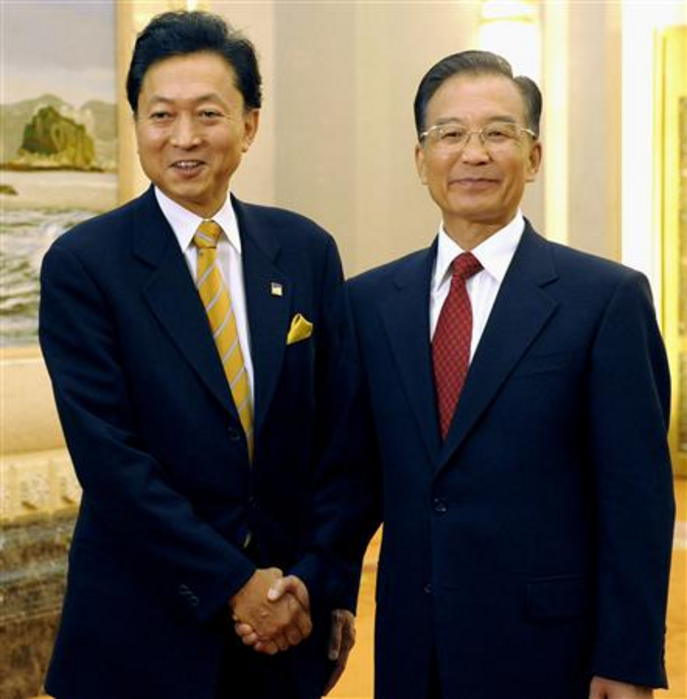 Hatoyama Yuki and Hu Jintao at the bilateral summit on October 10, 2009. There Hatoyama proposed the idea of transforming the East China Sea into a “Sea of Fraternité,” which was welcomed by Hu. Hatoyama Yuki and Hu Jintao at the bilateral summit on October 10, 2009. There Hatoyama proposed the idea of transforming the East China Sea into a “Sea of Fraternité,” which was welcomed by Hu. |
Yet the process of reconstituting state and economy in Japan to advance the clientelist and neo-liberal agenda is not without challenge. That challenge is best seen through focus on the contest between the national government, the bureaucracy, and almost all the national media on the one hand, and the people of one region, Okinawa, on the other, odds so unequal as to defy even such analogies as David and Goliath. The improbable fact as of early 2011 is that the advantage is with the Okinawan resistance and the nation state is on the ropes. For 14 years now, national governments, one after another, have declared various plans to foist new US Marine Corps high tech facilities on Okinawa but have been consistently beaten back. 2010 marked a significant upswing in the stakes, the intensity of the confrontation, and the overall balance of advantage. It is a mistake to see the Okinawan struggle as local, or “Okinawan,” because its implications are national, regional, and global with the nature of Japanese democracy and US strategic planning for its empire of bases across the Pacific in the balance. For example, the Okinawan resistance has already delayed US plans to expand its bases on Guam with the transfer (paid largely by Japan) of 8,000 Marines and dependents from Okinawa. In 2011 the best hope for peace and democracy in Japan and throughout the region is the continuing success of the Okinawan struggle in stalemating US-Japan plans for base reorganization and expansion.
It should be unnecessary to revisit here the Okinawa story of 2010, but in broad outline it included the following: in January the election of a Nago City mayor who declared that “no new base will be built in this city, whether on land or on sea;” in February the adoption by the Okinawa assembly of a unanimous resolution to the same effect; in April the gathering of the “All-Okinawan” mass meeting of some 90,000 people, including the Governor and heads of all local governing authorities, to reinforce the same demand (prefectural support for such positions was running at 84 per cent levels, according to a Ryukyu Shimpo opinion survey); followed in May by the “surrender” and then resignation of Prime Minister Hatoyama. Hatoyama under overwhelming American and Japanese bureaucratic and media pressure, capitulated, signed the 28 May agreement with Washington, and promptly resigned. The year turns on the axis of that infamous agreement, which Tokyo University political scientist Shinohara Hajime described as “Japan’s second defeat” (i.e., ranking with the surrender of 1945).1
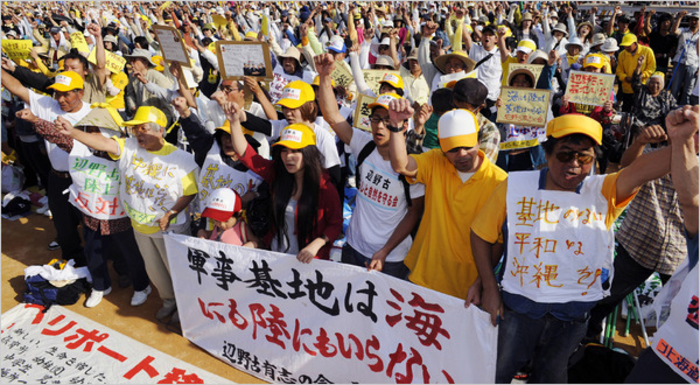 All-Okinawa rally of April 25, 2010 to oppose construction of a new base in Henoko (Photo by New York Times) All-Okinawa rally of April 25, 2010 to oppose construction of a new base in Henoko (Photo by New York Times) |
The new Prime Minister made it his priority to “restore” relations with Washington, which meant to restore the relationship of faithful service. Kan and his ministers repeatedly bowed their heads to Okinawa saying how sorry they were that they had had to renege on their pre-election pledges that Futenma would not be replaced with a new base within Okinawa, but that there was no alternative and the matter was closed. Rather than seek to advance Okinawan interests by attempting to re-negotiate with Washington, Prime Minister Kan and his ministers concentrated instead on a search for a formula to overcome stubborn Okinawan resistance and to combat the extraordinary levels of hostility to Tokyo and the DPJ that its retreat had fostered. As confidence and trust in the DPJ collapsed, in the Upper House elections of July, it was unable to field a single candidate in Okinawa. In September, the pro-base forces (backed by Tokyo) were again decisively defeated in a Nago City Assembly election. In November, Nakaima Hirokazu was re-elected Governor, backed by the Kan government on the understanding that his opposition to any new base construction was less adamant than that of his opponent, in other words, in the expectation that he would be amenable to persuasion provided the price was right. The one candidate who explicitly endorsed the national government’s position for implementation of the May agreement to relocate Futenma to Henoko was dismissed with a derisory 2 per cent of the vote.
As 2010 wound down, the Japanese state chose the Emperor’s birthday holiday, on a day and at an hour when it expected the people’s defenses might be low, to launch an assault at what it presumed was one of the weakest point of the Okinawan resistance movement, beside Prefectural Road 70 in northern Okinawa.
 Takae Protest Tent (Photo by Norimatsu Satoko) Takae Protest Tent (Photo by Norimatsu Satoko) |
Just before dawn on December 22nd, the Okinawa Defense Bureau (ODB, the Okinawan branch of the Japanese Ministry of Defense) re-started construction of new US helipads in Takae, a village in Yanbaru Forest, rich with 4,000 species of wild life. The plan, defying local protest, is to build six helipads within the Northern Training Area in exchange for returning half of the massive US Marine jungle training center. The helipads are to accommodate the V-22 Osprey – an accident-prone aircraft, capable of vertical and parallel take-off and landing. Residents of the 160-household Takae village have been sitting-in around the clock to protest the helipad construction plan since 2007. In November 2008, the ODB prosecuted 15 protesters for obstructing traffic, and though the suit was dropped for 13 of them, two were charged, and the case is continuing.
On the night of December 23rd, in deliberate harassment, a military helicopter hovered 15 meters above the sit-in tent, blowing it down and damaging its contents. Residents immediately filed a complaint against ODB, demanding investigation. When local residents went to the ODB office on December 28 with Okinawan members of the Diet and Prefectural assembly, ODB chief Mabe Ro was not available to meet them. When they finally met several hours later, he merely repeated that the US military had not confirmed the incident. Having visited the Takae tent only a few days before the incident, we note that the new Takae helipads and the “Futenma Replacement Facility” in Henoko are both to be Osprey-capable. If the helipad construction at Takae were to proceed , this would pave the way for forcible construction of the Henoko base. It would also mark a significant reversal of a 14 year-long successful people’s struggle.
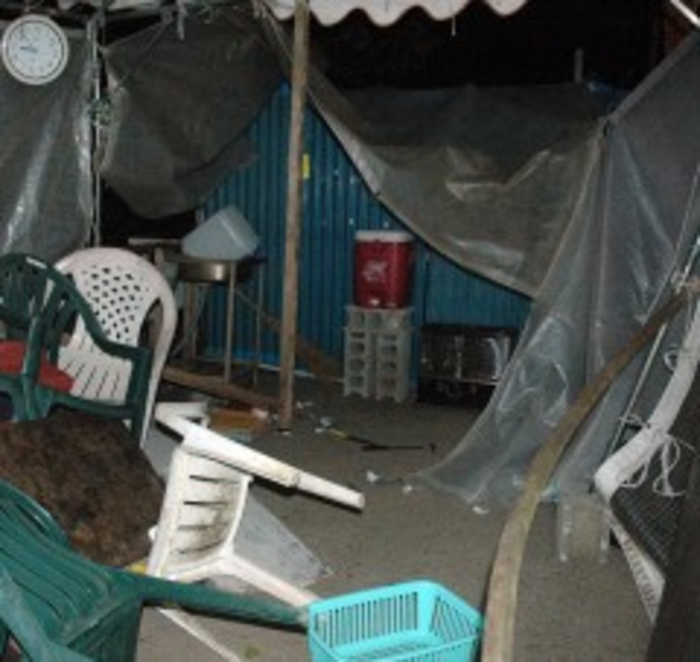 Inside the damaged tent, an hour after the helicopter hovering incident in Takae(Photo from Ryukyu Shimpo) Inside the damaged tent, an hour after the helicopter hovering incident in Takae(Photo from Ryukyu Shimpo) |
In 2010, the Japanese government tightened the screws on Nago City for its stubborn refusal to submit to base construction plans by suspending part of its budget, explicitly restoring the “carrot and sticks” link between base consent and fiscal policy that it had earlier denounced on the part of the LDP. The Kan government also threatened Governor Nakaima and the Okinawan people by intimating that unless Okinawa surrendered to Tokyo, the dangerous and disruptive Futenma Marine base would remain indefinitely. Cabinet Secretary Sengoku Yoshito told a Tokyo press conference that Okinawans would have to “grin and bear” (kanju) the new base. Within days, public outrage forced him to withdraw his words. In December 2010, Prime Minster Kan flew in to Okinawa, expressed his “unbearable shame as a Japanese” at the way the prefecture had been treated only to go on to say that relocation of the Futenma base to Henoko “may not be the best choice for the people of Okinawa but in practical terms it is the better choice.” Governor Nakaima countered that the Prime Minister had got it wrong, and that any relocation within the prefecture would be “bad.” Kan, as he entered the prefectural hall on December 17 to meet with Nakaima, encountered some 500 protesters outside the building. Their placards read “Rescind!” (the US-Japan plan to build a base in Henoko), and made noises with cans, mocking Prime Minister “Kan” as an empty “can.”
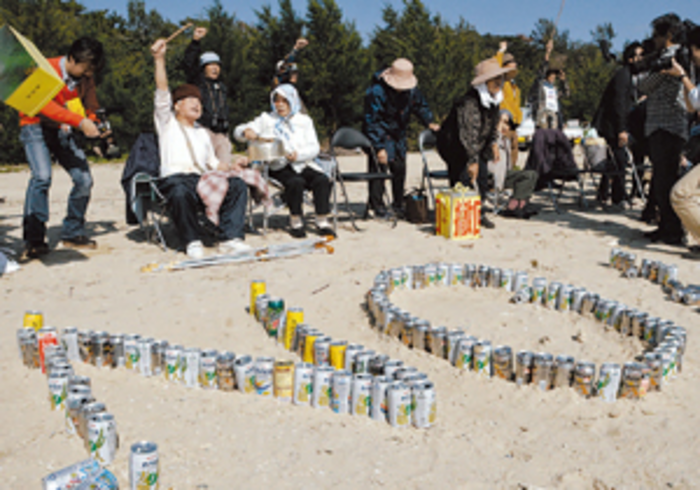 Protesters showing “NO” formed with empty cans on Henoko Beach, so Prime Minister Kan can see from his helicopter. (Photo from Okinawa Taimusu) Protesters showing “NO” formed with empty cans on Henoko Beach, so Prime Minister Kan can see from his helicopter. (Photo from Okinawa Taimusu) |
So apparently fearful was the Prime Minister of the reception he could expect from Okinawans that, on this December visit, he met no one but the Governor. Avoiding even the members of his own party, he presented a forlorn spectacle surveying his rebellious prefecture from the safety of an SDF helicopter. It is hard to think of any previous Prime Minister in modern times so distrusted and rejected in any part of the country.
While these Tokyo visitors pressed their unwelcome suit upon Okinawans, a different set of visitors gathered in Naha with prominent members of the Okinawan resistance and their academic and other citizen leaders and activists.Days later, Foreign Minister Maehara Seiji followed Kan to Okinawa. When he offered to address the dangers posed by the Futenma base by saying that he would relocate the schools and hospitals of the densely populated Ginowan, local people were incredulous and Governor Nakaima denounced as “the utmost degeneracy” any suggestion that Futenma air base might become permanent. “The basic problem, he said, “is to advance by even one day the removal of the dangers of Futenma, and it is turning things upside down to start extrapolating from the assumption that it is going to be permanent.”2
A December 19 forum cosponsored by the Asia-Pacific Journal (APJ) and Okinawa University, addressed the question “Where is Okinawa going?” Speakers at three sessions – environmental, geopolitical, and economic – engaged in discussion with nearly 200 participants on goals and ideals while addressing contemporary challenges to Okinawa and the region.
Kawamura Masami, Director of Okinawa BD (Citizens’ Network for Biological Diversity in Okinawa), an NGO that fielded one of the largest representations at the 10th Conference of Parties to the Convention on Biological Diversity in Nagoya, October 2010, discussed Okinawa BD’s activities, illustrating characteristics and difficulties of “politicized” environment movements in Okinawa while suggesting strategies to overcome obstacle to broader civil participation. Sakurai Kunitoshi, an environmental assessment specialist, emphasized civil society engagement to empower and provide leadership for Okinawans to rebuild the prefecture, by taking advantage of Okinawa’s rich environment based upon the principles of “Conserve, Use, and Know the environment.”
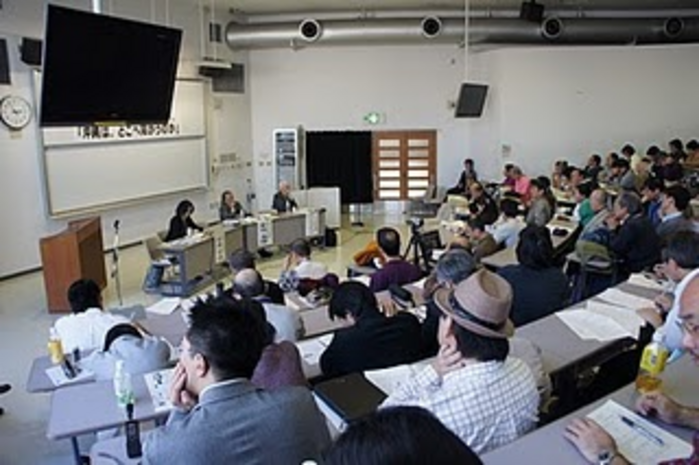 Forum “Where is Okinawa Going” held at Okinawa University, December 19, 2010 Forum “Where is Okinawa Going” held at Okinawa University, December 19, 2010 |
Amid rising tensions in East Asia, typified by the China-Japan conflict over the Senkaku/Diaoyu Islands, historian Arasaki Moriteru and APJ coordinator Gavan McCormack spoke of the danger of Okinawans getting caught up in the Japanese national narrative of their islands as “inherent territory” of Japan. Arasaki stressed Okinawa’s significance as a “space of livelihood” for people in the area’s fishing community, while McCormack presented an international vision of Okinawa as a place in the Asia-Pacific notable for its tradition of serving as a peaceful bridge between China, Korea, Japan and insular areas.
In the final session, political scientist Shimabukuro Jun pointed out that Okinawa’s history of “economic development” has only reinforced its status as a military colony and made it an integral part of the post-war AMPO (US-Japan security treaty) system, which de facto overrides Japan’s peace constitution. Shimabukuro called for a redefined local autonomy and legislation that would provide Okinawa with “regional sovereignty.” Miyagi Yasuhiro, a former Nago assembly member who led the 1997 plebiscite that said “no” to the Henoko base plan, explained that Nago had never prospered under the system of subsidies (bribes) from the Japanese government in exchange for hosting military bases. He urged Okinawans to unite in opposing military base expansion, and to engage in new forms of economic and social planning when the government’s Okinawa development program expires in 2012.
The forum’s nearly two hundred participants, boosted no doubt by anger at Prime Minister Kan’s cavalier visit to Okinawa the previous day, discussed the issues of Okinawa’s future within the broader context of alternative courses for the Asia-Pacific region notable both for economic dynamism and the dangerous clashes taking place in 2010. Expansive plans for US base construction in both Okinawa and Guam thus need to be assessed in light of the responses to conflicts between North and South Korea and between China and Japan, responses notable for provocative joint US-Japan-South Korea military exercises replicating the Cold War alliance structures of the 1950s and directed against China and North Korea. Above all, the subordination of Okinawa to US and Japanese security concerns—intensified in the wake of the clash over the Senkaku/Diaoyu islands—needs to be set off against alternative environmentally sound and peaceful possibilities for a region whose history throughout the long twentieth century has been one of sacrifice to imperial and military demands.
In short, the significance of the long-running Okinawa struggle extends far beyond the projected base construction and transfer. The sharp focus on Futenma (and Henoko) has always been tactical, but it is also a measure of the careful strategic planning and organization that underpinned the long-running Okinawan struggle. Even if, as one Okinawan newspaper calculated, Futenma was indeed returned to its owners without replacement, the outcome would merely be to reduce Okinawa’s percentage of the total US base land in Japan from 74 to 72 per cent. While the tactical focus is therefore indisputably Futenma/Henoko/Takae, Okinawan civil society’s strategic orientation has always been towards demilitarization in general, the implementation of the Japanese constitution, especially Article 9 (peace), 12-40 (human rights and livelihood), and 92-95 (local self-government) in particular, and, particularly given Okinawa’s close proximity to China, Taiwan, and Southeast Asia, alternative regional economic possibilities. It is high time to overcome Okinawa’s subordination to the imperatives of the US-Japan Security Treaty.
Beyond the base confrontation, Okinawans are able to see with increasing clarity, through the exposures of “secret diplomacy” and other revelations of the inner workings of the government and the US-Japan-Okinawa relationship, that they had been consistently lied to, tricked, and cheated within the state system they were incorporated in from 1972. That was the case in the deals that Tokyo thrashed out with the Nixon administration in the late 1960s leading to the 1972 reversion and was equally the case in the deals done by the Democratic Party government in Tokyo with the Obama administration in 2009-10. Detail after detail confirms the pattern and demonstrates Tokyo’s contempt for Okinawa and its ongoing efforts to neutralize Okinawan democracy.
In 1965, as was disclosed only recently in declassified documents from the US archives, then US ambassador Edwin Reischauer (éminence grise of Japanese studies in the US through much of the post-war era), proposed a formula for managing Okinawa: “if Japan would accept nuclear weapons on Japanese soil, including Okinawa, and if it would provide us with assurances guaranteeing our military commanders effective control of the islands in time of military crisis, then we would be able to keep our bases on the islands, even though ‘full sovereignty’ reverted to Japan.”3 Nuclear weapons were later in fact removed, but otherwise the Reischauer formula has underpinned the Okinawan position within the US-Japan relationship ever since: free use of the bases under “full sovereignty” – words as requiring of parentheses now as then.
Reischauer’s further 1965 advice on the channelling of discreet funds to aid conservative (pro-US) candidates in elections was also followed, and essentially has been followed in Okinawan elections ever since, though in more recent times the Japanese government has substituted cabinet secretariat secret funds for the CIA or other, direct, American sources. The way in which the crucial 1998 election, in which determinedly anti-base Governor Ota Masahide was defeated following large infusion of those special funds is just one of the many revelations of 2010.4
The Okinawan City of Nago has attracted particular attention from the Japanese nation state for the past 14 years because its initially local resistance to the base construction project, first materializing in the 1997 plebiscite in which a clear majority opposed any new base construction, slowly spread prefecture-wide and now shows signs of spreading to the rest of Japan. Massive Tokyo interventions against Nago—in the form of bribery and coercion—followed the 1997 Nago Plebiscite in a desperate effort to crush or neutralize this local democratic will. Continuing without break, they led to the DPJ’s abject failure in the Nago election of 2010. By holding the nation state, and its US backer, at bay for that time, the citizens of Nago (and more broadly of Okinawa as a whole) have already accomplished a huge victory. It remains to be consolidated, and Tokyo today imposes new fiscal sanctions on the city to try to wrest submission from it. The Nago accomplishment is a victory for democracy in one city, but it will remain a brittle victory until it is consolidated first at prefectural and then at national level. As we argue in the New Year edition of theRyukyu shimpo, it is time now to go from 14 years of successful resistance to a new phase in which positive Okinawan agendas, programs and vision are articulated to help lift Japan as a whole out of the doldrums of subordination to American power and policies.5
Forty years ago, in December 1970, the citizens of Koza (now Okinawa City) rose up in anger at the trampling on their rights by the US occupying forces. In a single night, they destroyed more than 80 US military and private vehicles and many buildings in a spontaneous burst of rage. These events, known generally as the “Koza Riots,” are better described as the “Koza Uprising,” for this was the sole occasion in post-war Japan in which Okinawan or Japanese people actually rose up, desperately if futilely, against US military occupation. Forty years on, a former official of the city lamented that “fundamentally, nothing has changed … in the name of democracy, we have had an occupation, with the same treatment meted out to us as to Iraqis and Afghanis, while both the US and Japan turn a blind eye. The anger that exploded 40 years ago has not abated.”6
 Aftermath of Koza Uprising, December 20, 1970 Aftermath of Koza Uprising, December 20, 1970 |
Okinawa was once the independent Ryukyu Kingdom, negotiating treaties with neighboring foreign countries and kingdoms through the 1850s and only fully subordinated within the modern Japanese state in 1879. As resentment deepens today over ongoing discrimination, some begin to draw attention to the past, and to suggest a future either on a renegotiated and more autonomous basis within the Japanese state or as an independent entity outside it. In June 2010, a “Declaration of Independence” was issued at a meeting on Iriomote Island, in the name of “The Federation of Ryukyu Self-Governing Republics.” Its initial demands of the Japanese national government included apology and compensation for the abolition of the Ryukyu Kingdom and subordination of the islands as Okinawan prefecture in 1879, abolition of the Reversion Agreements of 1969-72 (on grounds of dubious legality and the complex of secret deals that enveloped them) and negotiation of a new, autonomous status.7 The past is unlikely to be a sure guide to the future, but as resentment builds, and so long as Ampo (the US-Japan Security Treaty) continues to take precedence over Kempo (the constitution of Japan, with its core principles of peace, human rights, and self-government), support for independence will grow.8
On December 17, the Japanese Cabinet approved the New National Defense Program Guideline, which stressed increasing confrontation over the “grey zones” and identified the threat of the military modernization of China as part of the “Security Environment Surrounding Japan.” It unveiled a plan to enhance the SDF presence in “southwestern Japan,”9 including Ishigaki. Four days later, we called on Ohama Nagateru, former Mayor of Ishigaki. Ohama, as mayor from 1994 to 2010, had encouraged citizens to establish an Article 9 (no-war clause of the Japanese Constitution) monument in the city, and had initiated various projects to strengthen ties with Taiwan and China, including a sister city agreement with Su-ao, Taiwan. While Tokyo was proposing to reinforce the SDF on the Sakishima Islands, the southernmost islands of Japan bordering China/Taiwan and including Ishigaki, Ohama took a very different view.
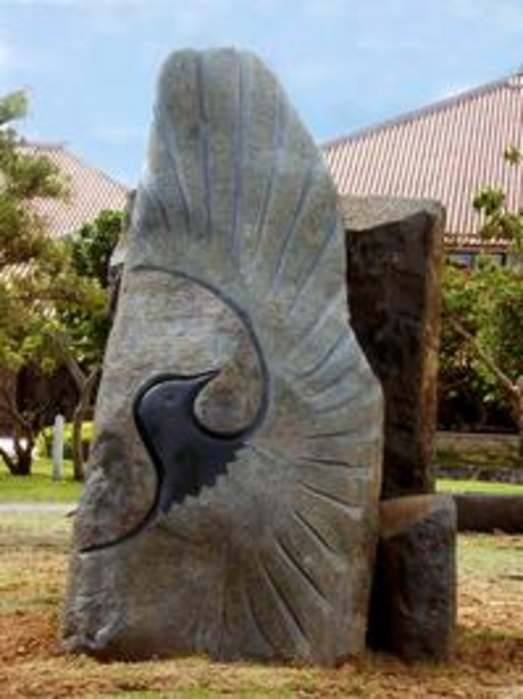 Article 9 monument on Ishigaki Island (Photo from JANJAN) Article 9 monument on Ishigaki Island (Photo from JANJAN) |
“We don’t need the SDF on these small islands near the border,” he said, explaining that a fishery rights agreement was on the verge of being completed around the contested Senkaku/Diaoyu Islands before the September 7 ship collision that led Japan’s Coast Guard to detaining the captain of the Chinese fishing boat, thereby provoking an international incident. “A territorial dispute certainly can lead to war,” he said, warning against the military build-up around the border. Ohama also stressed the island’s bitter collective memory of the Japanese military’s failure to protect local citizens in the past. During the Battle of Okinawa, 3,800 people, one out of seven on the island, died of malaria, as local citizens were forced by the Japanese military to move to a malaria-infested mountain area. Ohama, who lost in the February 2010 mayoral election to LDP/Komeito-backed Nakayama Yoshitaka, warned of recent provocative moves by city officials, such as two city assembly members landing on one of the disputed Senkaku islands, and passage of a law designating January 14 as “Senkaku Day” to commemorate the day in 1895 when Japan incorporated the islands as its territory, now part of Ishigaki City in Japanese understanding.
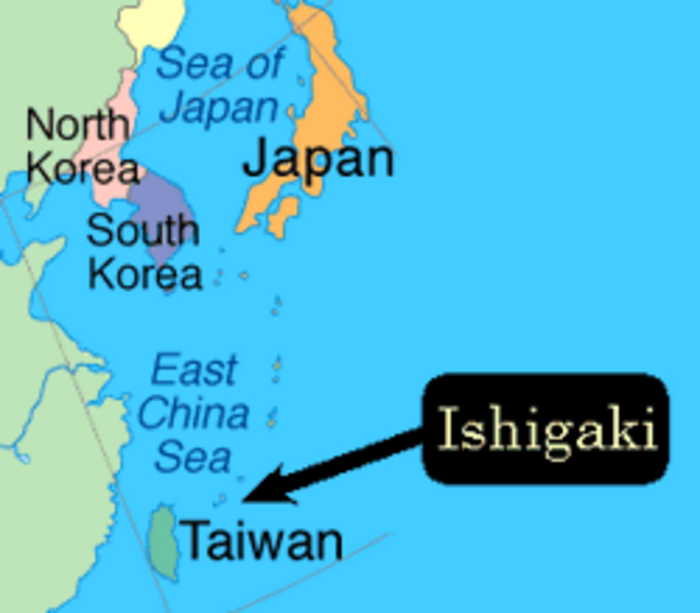 Ishigaki Island (Map from Ishigaki Tourist Information website) Ishigaki Island (Map from Ishigaki Tourist Information website) |
Nago Mayor Inamine’s determination to prevent construction of a base in his city has assured that Nago remains at the forefront of Okinawan resistance. In July 2010, the Mayor refused to permit the Okinawa Defense Bureau to conduct a further assessment with an eye to building a Futenma replacement base. Inamine’s bold act recently gained nationwide support, as hundreds of people elsewhere in Japan transferred their resident tax to Nago, in response to the Defense Ministry’s suspension of a 1.6 billion yen (approximately 20 million US dollars) “realignment subsidy,” one provided specifically to municipalities that host US military bases during the base construction process. The payments of those who have chosen to pay their tax to Nago instead of to the municipality of their residence is small (as of January 6 just 4.7 million yen, or approximately 60,000 US dollars),10 insignificant against the forgone subsidy. But it carries the symbolic meaning of citizens’ support to a city that is determined to finance its own economic activities, even resisting central government bribery for hosting a new base. In late December 2010, Inamine told a group of American University students visiting Okinawa, that “People here are hanging on to their conviction not to allow another base in Okinawa, and not to succumb to state power. I would like young people like you to go back to the US and tell people about it.”
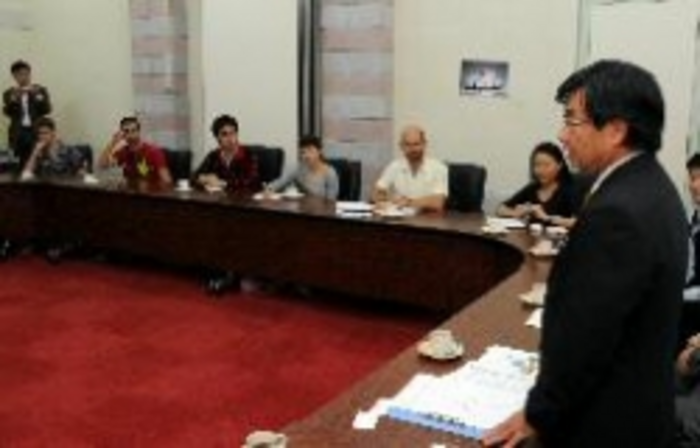 Nago Mayor Inamine speaks to US students(Photo from Okinawa Taimusu) Nago Mayor Inamine speaks to US students(Photo from Okinawa Taimusu) |
The New Year Day issue of Ryukyu Shimpo carried encouraging news for anti-base forces. As of December 31, 2010, an unprecedented number of over 20,000 plaintiffs have joined the collective lawsuit against the government over the noise pollution of Kadena US Air Force Base. This is the third such lawsuit, the first being in 1982 and the second in 2000. The second was called a “mammoth lawsuit,” with 5,500 plaintiffs, one-fourth the present number. The second lawsuit demanded that the government ban landing and take-off between 7 pm and 7 am, restrict aircraft noise, and pay compensation for the psychological damage inflicted by the noise. The third lawsuit is expected to make similar demands.
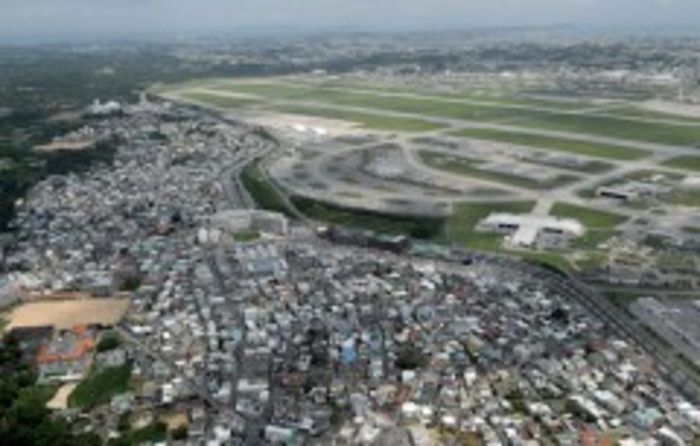 Kadena US Air Force Base and adjacent neighborhood (Photo from Ryukyu Shimpo) Kadena US Air Force Base and adjacent neighborhood (Photo from Ryukyu Shimpo) |
The Kadena-based F-15s are among the aircraft that impose the greatest burden on surrounding neighborhoods. About one hundred aircraft are permanently stationed and operated there, and foreign-based planes also frequently visit. Residents complain of being woken up by 110-120 decibel sound blasts, the kind of noise one hears when a car revs its engine from one meter away. In the first two lawsuits, the high court turned down the plaintiff’s demand for a flight ban, saying it was a third-party (US military) operation that the Japanese government could not control. The plaintiffs of the second lawsuit have appealed to the Supreme Court.
Takara Tetsumi, a constitutional law specialist at the University of Ryukyus compares this large-scale suit to the movement for Okinawan reversion to Japan prior to 1972, both based on the constitutional principle of the right of peaceful existence. Ryukyu Shimpo calls the lawsuit “a modern-day popular uprising.”11 The suit, coming at a time when China-Japan tensions have led to heightened pressures for militarization, is the latest sign that Okinawa will continue at the center of efforts to define Japan’s future.
Gavan McCormack, Norimatsu Satoko and Mark Selden are coordinators of The Asia-Pacific Journal. They visited Japan, including Okinawa and Ishigaki, in December 2010, and were joint organizers and participants in the Forum at Okinawa University, “Where is Okinawa Going?”
Recommended citation: Gavan McCormack, Norimatsu Satoko and Mark Selden, New Year 2011, Okinawa and the Future of East Asia, The Asia-Pacific Journal Vol 9, Issue 2 No 3, January 10, 2011.
Notes
1 See Gavan McCormack, The Battle of Okinawa 2010: Japan-US Relations at a Crossroad.
2 Okinawa Taimusu, 29 December 2010.
3 Steve Rabson, “‘Secret’ 1965 memo reveals plans to keep US bases and nuclear weapons in Okinawa after reversion,” The Asia-Pacific Journal, 21 December 2009.
4 Ida Hiroyuki, “Kambo kimitsuhi yaku 3 oku en ga Okinawa chijisen ni nagarekonda shoko,” Shukan kinyobi, 22 October 2010, p. 20-21.
5 “Teiko koeta bijon o,” Ryukyu shimpo, 4 January 2011.
6 Okinawa Taimusu, 17 December 2010.
7 On the Declaration of Independence issued by “Ryukyu Jichi Kyowakoku Renpo” (by the alliance of Amami, Okinawa, Miyako, and Yaeyama islands) on 23 June 2010, see Matsushima Yasukatsu, “Yuimaru Ryukyu no jichi – ‘Ryukyu’ dokuritsu de ‘heiwa na shima’ e,” Shukan kinyobi, 23 July 2010, p. 22; also “NPO Hojin Yuimaru Ryukyu no jichi,” (link).
8 Paraphrasing the sentiment expressed by Ryukyu University’s Shimabukuro Jun, “Jichishu to nari kizuna o saisei suru,” Asahi shimbun, 24 August 2010.
9 Japan Ministry of Defense, Summary of National Defense Guidelines, FY2011.
10 “Furusato nozei kyuzo,” Ryukyu Shimpo, 6 January 2011
11 For discussion on the Kadena noise lawsuits, see “Kokunai saidai genkoku 2 man kyo ? Kadena bakuon 3ji sosho, 2ji no 4bai,” Ryukyu Shimpo, 1 Jan 2011 (link) and“Genkoku 2man kyo gendai no minshu hoki dahiko sashitome ni fumikome,” Ryukyu Shimpo, 3 Jan 2011 (link).
